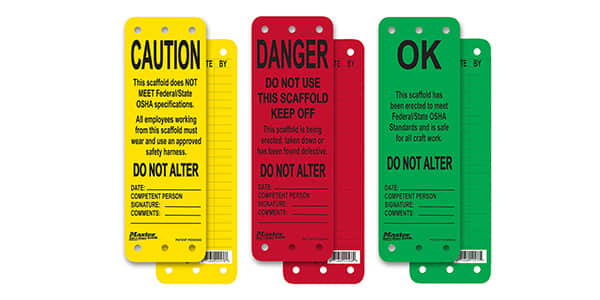Décryptage des exigences relatives aux étiquettes d'échafaudage
Jun 24, 2025Échafaudage est une pratique courante dans le monde entier. Les échafaudages offrent une fonctionnalité temporaire et un support structurel permettant aux employés d'accéder à la zone de travail en toute sécurité, même à 6 mètres du sol (ou plus). Les véritables systèmes d'échafaudage sont géométriquement très simples. Cependant, de nombreuses réglementations de sécurité régissent leur construction et leur utilisation, et l'étiquette d'échafaudage elle-même n'en est qu'un élément, une exigence souvent négligée. Une étiquette d'échafaudage est un simple autocollant voyant, mais elle représente bien plus qu'un simple autocollant. Elle sert de moyen de communication, d'affirmation de sécurité et constitue une obligation légale pour contrôler et garantir la sécurité de toute personne empruntant un échafaudage.
Ce blog couvrira tous les aspects des réglementations relatives aux étiquettes d'échafaudage, y compris pourquoi elles existent, ce qu'elles signifient et pourquoi le respect des directives relatives aux étiquettes d'échafaudage n'est pas seulement une bonne pratique, mais crucial pour prévenir les incidents et préserver la vie.
Les étiquettes d'échafaudage sont, à la base, un marqueur visuel fixé à l'un ou l'autre des points d'accès d'un échafaudage. Elles indiquent l'état actuel de l'échafaudage et orientent les utilisateurs vers les informations essentielles pour savoir s'ils comptent l'utiliser. On peut comparer ces étiquettes à un feu de signalisation : vert (utilisation sûre), jaune (attention, restrictions possibles) et rouge (arrêt).
Bien que l'appareil puisse sembler différent et que les couleurs puissent varier en fonction des lois/codes locaux et de la politique de l'entreprise, dans l'ensemble, la fonction essentielle reste la même : communiquer l'état d'utilisation et de sécurité aux utilisateurs de l'échafaudage de manière claire, immédiate et directe.
Pourquoi ces étiquettes sont-elles si importantes ? Elles sont étroitement liées à certains aspects importants de la sécurité et du fonctionnement, tels que :
Bien que les conceptions diffèrent, la plupart des étiquettes d'échafaudage complètes contiendront les détails essentiels suivants :
Codage couleur : comme indiqué précédemment, la couleur sera généralement l'identifiant principal de l'état de l'échafaudage.
Vert: Indique que l'échafaudage peut être utilisé en toute sécurité, qu'il a été entièrement inspecté et qu'il répond à toutes les normes de sécurité.
Jaune/Ambre : Indique une mise en garde. L'échafaudage peut être incomplet, en cours de modification ou présenter des limitations spécifiques. Des détails sur les limitations de l'étiquette seront généralement fournis.
Rouge: Indique que l'échafaudage est dangereux, en construction, en cours de démontage ou hors service en raison de défauts. L'accès est strictement interdit !
Capacité de charge/Limitations : Indispensable pour les échafaudages soumis à des restrictions de poids spécifiques ou à d'autres limitations (par exemple, nombre maximal de personnes, types d'outils autorisés) inférieures à la capacité de charge totale de ce type d'échafaudage. Dans ce cas, une étiquette jaune est généralement utilisée.
Prochaine date d'inspection (facultatif) : Certaines étiquettes indiquent la date de la prochaine inspection. Cela facilite la gestion du planning et la sécurité.
Nom/Logo de l'entreprise : identifie l'entreprise responsable de l'échafaudage (et/ou de l'inspection).

Une étiquette verte signifie que l'échafaudage a été entièrement monté, inspecté par une personne compétente et jugé sûr pour le chantier. Tous les composants sont fixés, les haubans sont sécurisés et tous les points d'accès sont jugés sûrs. Les travailleurs peuvent poursuivre leurs travaux en toute confiance.
Une étiquette jaune indique généralement une situation ou un champ d'application où l'échafaudage est incomplet, en cours de modification ou où d'autres conditions spécifiques doivent être communiquées. Par exemple :
Une étiquette rouge indique une interdiction absolue. Cet échafaudage est dangereux en toutes circonstances pour les raisons suivantes :
En aucun cas, il est interdit d'entrer ou de travailler sur un échafaudage portant une étiquette rouge. Il s'agit d'une règle de sécurité non négociable.
Le respect des exigences en matière d'étiquetage des échafaudages ne consiste pas seulement à coller une étiquette sur une structure ; il implique une approche globale de la sécurité :
Les étiquettes d'échafaudage sont bien plus que de simples morceaux de plastique ou de papier colorés ; elles sont essentielles à la sécurité des échafaudages. Elles fournissent des informations immédiates et cruciales sur l'état de l'échafaudage, permettant aux travailleurs d'évaluer rapidement sa sécurité avant utilisation. Outil de communication clair, vérifiant les inspections, mettant en évidence les dangers et favorisant la responsabilisation, ces étiquettes sont indispensables à la prévention des accidents et au respect de la réglementation. Le respect des exigences relatives aux étiquettes d'échafaudage, de leur placement correct et de leur inspection régulière par une personne compétente à la formation complète des travailleurs, constitue un engagement fondamental pour le bien-être de chaque personne qui monte sur un échafaudage, contribuant ainsi à un environnement de construction plus sûr et plus productif.
Qui est responsable de la pose et de la mise à jour des étiquettes d’échafaudage ?
À quelle fréquence les étiquettes d’échafaudage doivent-elles être mises à jour ou remplacées ?
Sécurité des échafaudages | Santé et sécurité environnementales | Virginia Tech —— VT
Personne compétente en matière d'échafaudages OSHA —— Formation 360